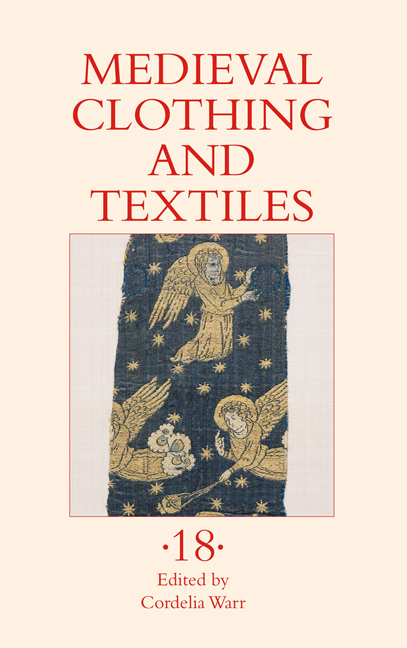Book contents
- Frontmatter
- Contents
- Illustrations
- Tables
- Contributors
- Preface
- 1 Linen Armour in the Frankish Countries: The Twelfth Century
- 2 Serial Production and Individualisation in Late Medieval Silk Weaving
- 3 The Trousseau of Isabella Bruce, Queen of Norway (The National Archives, Kew, DL 25/83)
- 4 Make and Create: The Craftswomen in the Salone Frescoes of the Palazzo della Ragione, Padua
- 5 Combs, Mirrors, and Other Female Beauty Bling in the Later Middle Ages
- 6 The Dividing Lines of Social Status in Sixteenth-Century Scottish Fashion
- Recent Books of Interest
- Author Index, Volumes 1–17
2 - Serial Production and Individualisation in Late Medieval Silk Weaving
Published online by Cambridge University Press: 10 May 2024
- Frontmatter
- Contents
- Illustrations
- Tables
- Contributors
- Preface
- 1 Linen Armour in the Frankish Countries: The Twelfth Century
- 2 Serial Production and Individualisation in Late Medieval Silk Weaving
- 3 The Trousseau of Isabella Bruce, Queen of Norway (The National Archives, Kew, DL 25/83)
- 4 Make and Create: The Craftswomen in the Salone Frescoes of the Palazzo della Ragione, Padua
- 5 Combs, Mirrors, and Other Female Beauty Bling in the Later Middle Ages
- 6 The Dividing Lines of Social Status in Sixteenth-Century Scottish Fashion
- Recent Books of Interest
- Author Index, Volumes 1–17
Summary
Whenever the conversation turns to single orders or special commissions in medieval silk weaving, sooner or later the altar hanging with a Crucifixion scene in Regensburg will be brought up as one of the most elaborate and exclusive commissions to have survived from the decorative arts of the Middle Ages (figs. 2.1 and 2.2).
The basic type of pictorial fabric is well known from medieval textile art. Starting from the thirteenth century, fabrics with subjects containing human figures are mentioned in merchants’ account books and church inventories. They can also be found among the surviving silk weavings of the period, depicting the Crucifixion of Christ along with a variety of other religious images, including various saints, the enthroned Virgin Mary, the Nativity, the Adoration of the Magi, the Entombment, and the Resurrection. Alongside these, secular scenes from courtly literature are also attested to as pictorial themes in woven silks.
However, all these fabrics containing human figures depict small-scale scenes, scarcely more than a hand span wide. They were products of the extensive use of serial production, by means of which the centres of the Italian silk industry supplied the European market. Like the later woven orphrey bands with figurative designs of the fifteenth and sixteenth centuries, they were manufactured as repeat patterns in countless repetitions, to be used as ornaments for secular or ecclesiastical clothing.
The Regensburg altar hanging is, in contrast, a unique piece with respect to its content, form, technique, and design. It originally measured about 120 centimetres (about 1⅜ yards) in height and 300 centimetres (3. yards) in width, and was commissioned by Heinrich von Rotteneck, the bishop of Regensburg from 1277 to 1296. The identity of the commissioner is made clear on the hanging, through both text and imagery. Kneeling in full pontificals, his hands raised in intercession, the bishop appears to the side of the Crucifixion scene, while a woven inscription gives his name and title. It may be assumed on this basis that Heinrich was both the commissioner and the recipient of the hanging. This type of full-figure donor portrait is unique in thirteenth-century silk weaving, representing the first occurrence in the history of European silk production.
- Type
- Chapter
- Information
- Medieval Clothing and Textiles , pp. 41 - 72Publisher: Boydell & BrewerPrint publication year: 2024



